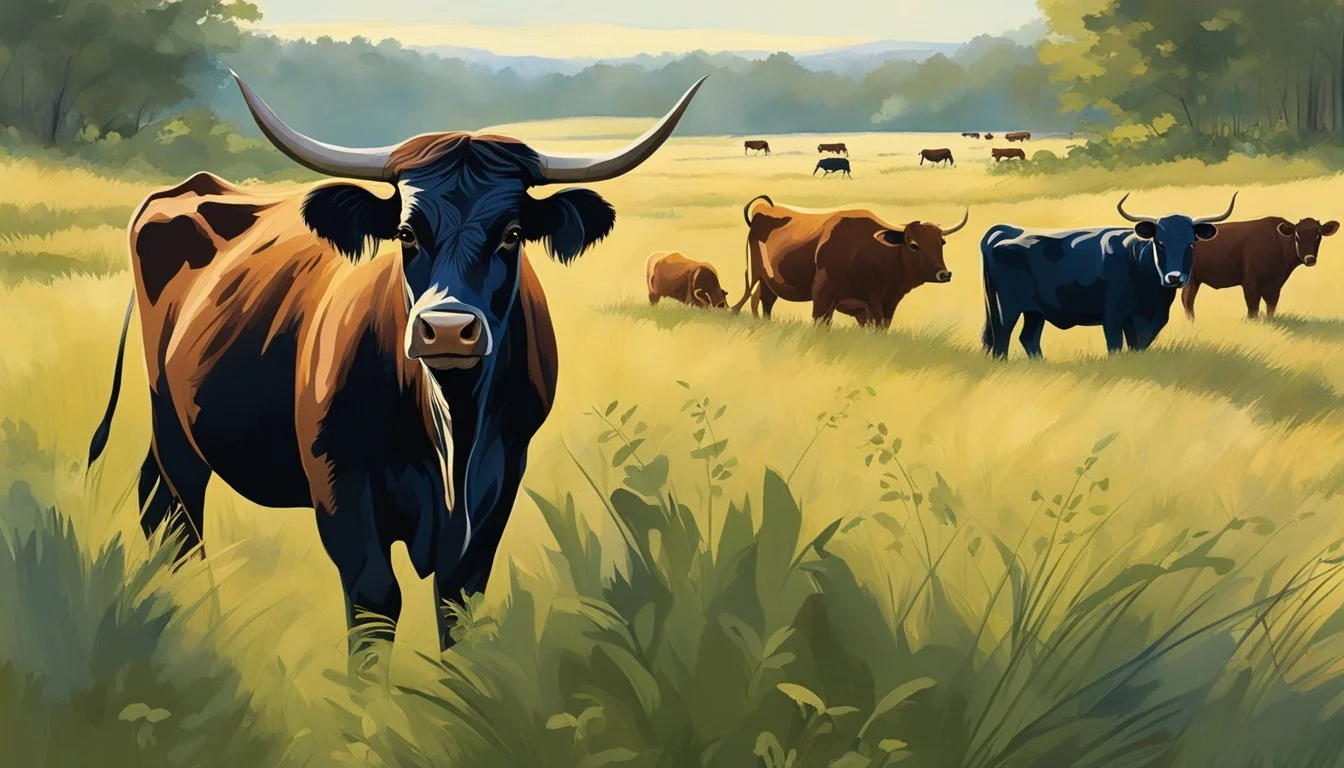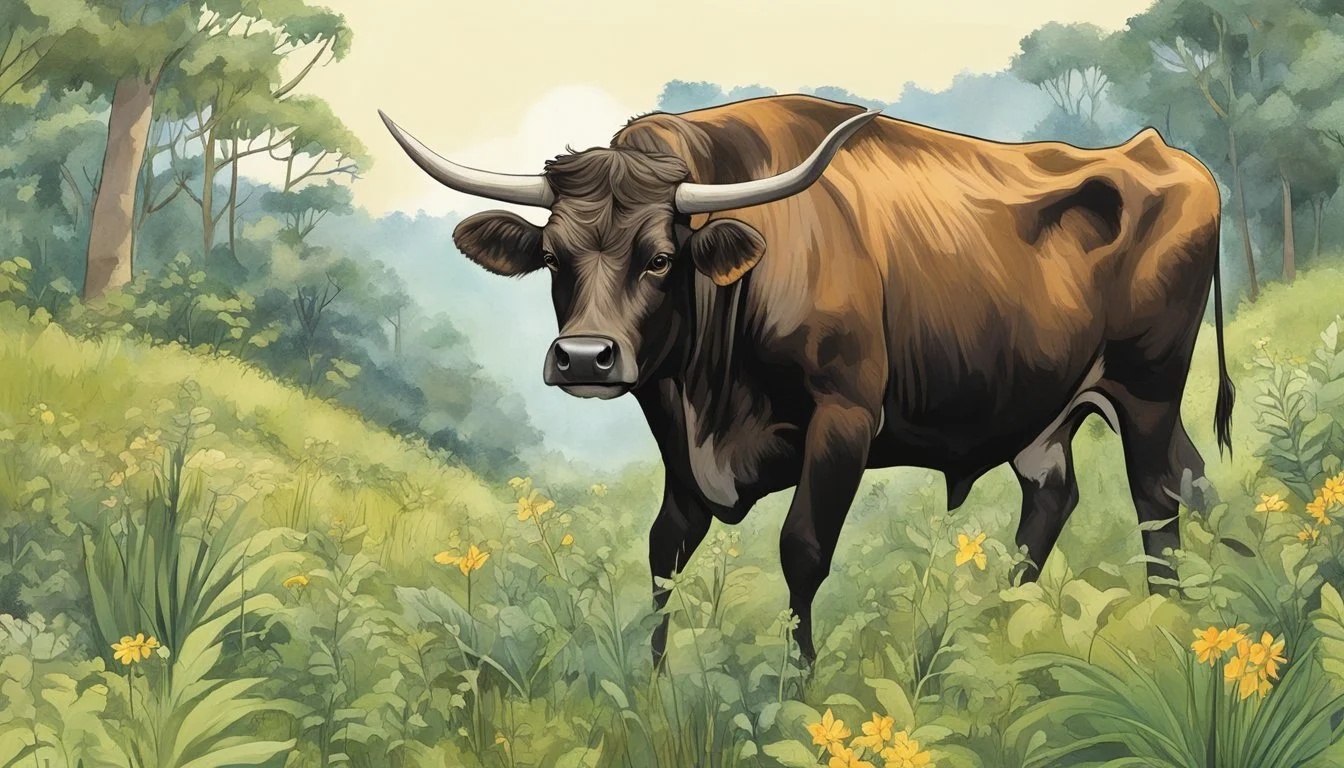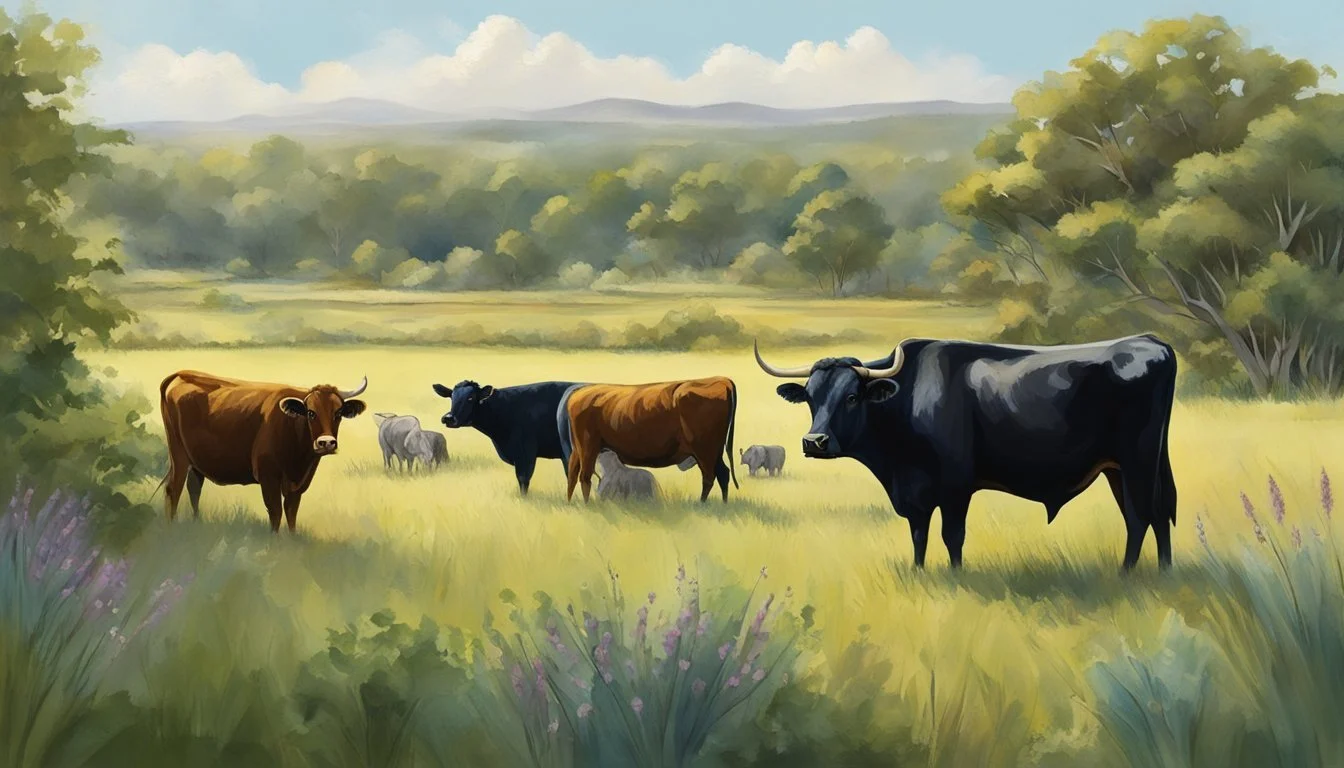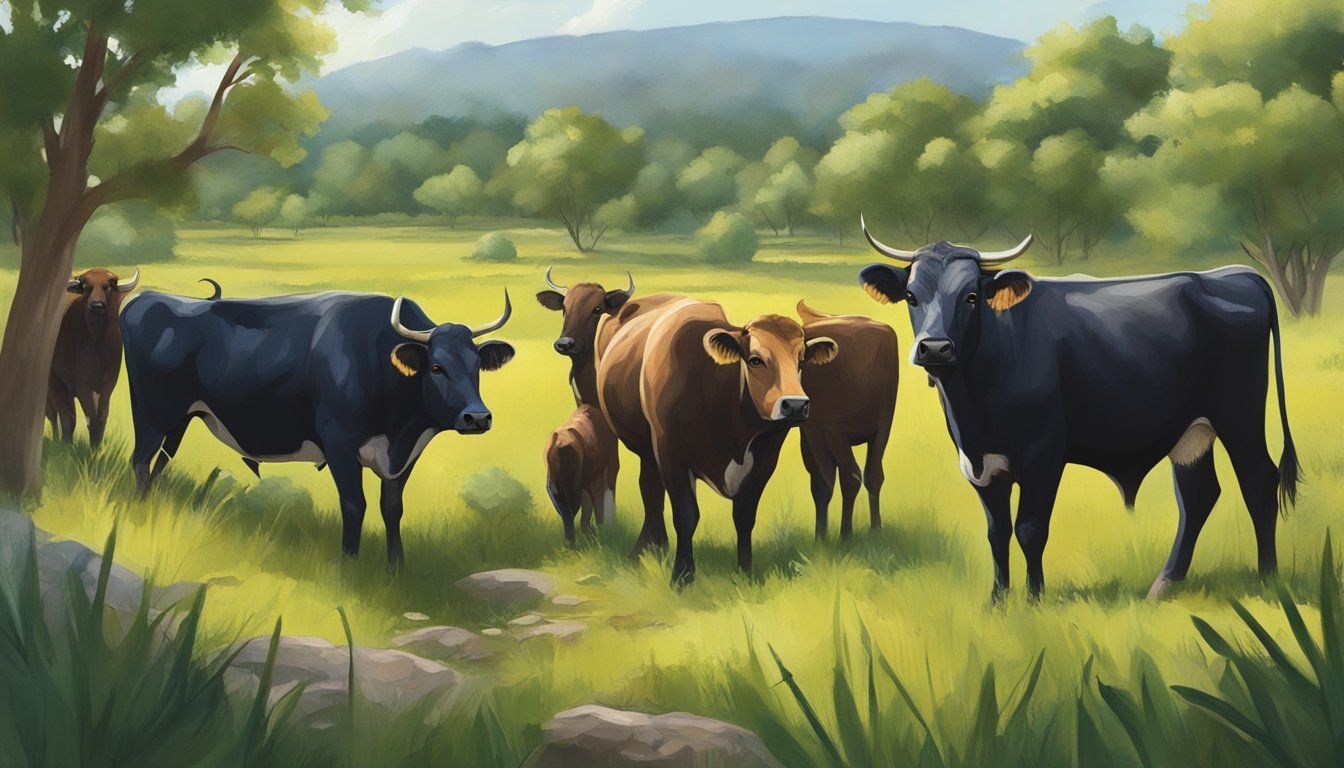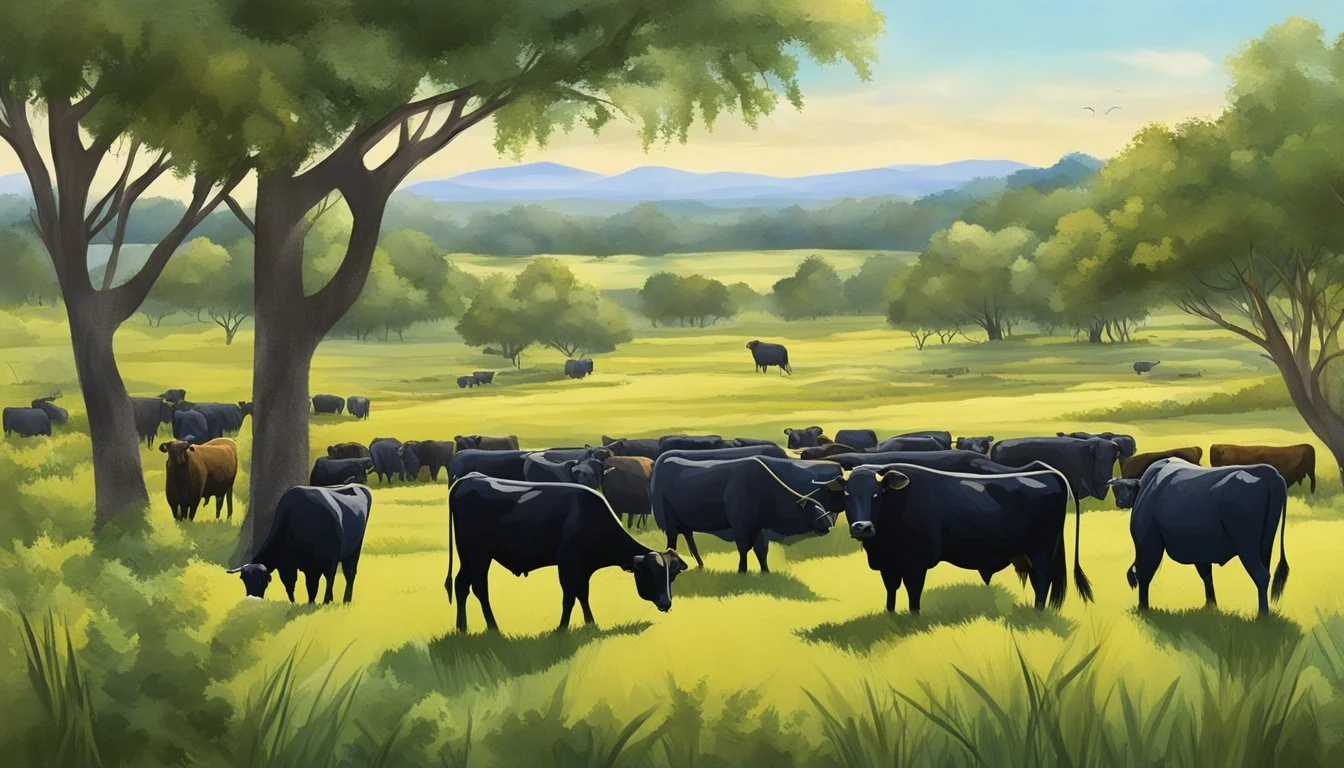The Impact of Dexter Cattle on Biodiversity and Wildlife Habitats
A Comprehensive Analysis
Dexter cattle, known as the smallest breed of cattle in Europe, have risen in popularity for their hardy nature and small size, making them particularly suitable for conservation and rewilding projects. As the pressure on land use intensifies with the need to balance agricultural productivity and conservation, these cattle are being recognized for their potential role in sustaining biodiversity. The management of livestock, including Dexter breeds, plays a critical role in shaping wildlife habitats, directly influencing the composition and richness of flora and fauna present.
The grazing habits of Dexter cattle can have multifaceted effects on ecosystem dynamics. On one hand, their grazing can help maintain open landscapes and prevent the encroachment of shrubs, which benefits certain wildlife species by creating a mosaic of habitats. On the other hand, livestock grazing can also lead to habitat degradation if not managed properly, potentially reducing the diversity and abundance of native wildlife. The impacts of grazing are complex and multi-trophic, as they not only affect the vegetation layers but also have cascading effects on the soil, invertebrates, and larger animals that are part of the ecosystem.
Given their small stature, Dexters require less fodder and are often viewed as less damaging to sensitive landscapes compared to larger cattle breeds. Recent research suggests that when managed appropriately, Dexter cattle and similar livestock can coexist with wildlife, contributing positively to biodiversity conservation efforts. To truly understand the scope of their impact, further studies are needed, incorporating standardized measurements of vegetation and comprehensive assessments of wildlife populations. This will enable land managers to make informed decisions that support both agricultural viability and biodiversity conservation.
The Significance of Dexter Cattle in Modern Agriculture
The use of Dexter cattle in modern agricultural practices presents sustainable and efficient livestock management solutions, aligning with conservation efforts to maintain diverse ecosystems.
Characteristics of Dexter Cattle
Dexter cattle are distinguished by their smaller size compared to other cattle breeds, yet they demonstrate remarkable hardiness well-suited for diverse weather conditions. Originally from Ireland, these cattle are known for their dual-purpose nature, providing both quality milk and meat. Their compact size makes them less demanding in terms of space and feed, which is optimal for small farms and sustainable agriculture.
Size: Smaller stature, approximately one-third the size of a traditional Holstein.
Hardiness: Adaptability to harsh climates.
Utility: Dual-purpose – milk and beef production.
Role in Livestock Production
Farmers value Dexter cattle for their efficiency in livestock production. They require less pasture and can be raised on marginal lands where larger breeds would not be as economical or effective. The breed's ability to thrive in less-intensive grazing systems contributes positively to the farming sector, especially within small-scale operations focusing on niche markets and locally-sourced foods.
Efficiency: Less resource-intensive, suited for small-scale farms.
Adaptability: Capable of thriving in varied agricultural environments.
Economics: Beneficial for niche markets and local food initiatives.
Heritage Breed and Conservation Efforts
As a heritage breed, Dexter cattle play a vital role in biodiversity conservation within agricultural landscapes. Conservation efforts often utilize their grazing to manage and maintain wildlife habitats, as they create a favorable environment for native flora and fauna. This breed's resurgence in popularity underscores its importance not only in agriculture but also in ecological preservation.
Biodiversity: Enhances local ecosystems through grazing habits.
Ecological Role: Management of habitats for wildlife.
Conservation Status: Growing interest in their role within rewilding and conservation projects.
Biodiversity and Ecosystem Services
The presence of Dexter cattle can significantly alter the biodiversity and ecosystem services within agricultural landscapes. The effects extend from the soil to diverse species that inhabit these ecosystems.
Biodiversity in Agricultural Landscapes
Dexter cattle, a breed known for its smaller size and efficient grazing habits, can influence biodiversity within agricultural ecosystems. Their grazing patterns can affect plant diversity, promoting a heterogenous landscape. Biodiversity underpins the stability and resilience of ecosystems, making its conservation essential. In the context of agricultural landscapes, the diversity of species contributes to the overall health of the environment, acting as a bulwark against pests and diseases that might otherwise thrive in a monoculture.
Impact on Soil: Dexter cattle's grazing can improve soil quality and structure which is vital for plant diversity.
Conservation Efforts: Grazing by Dexter cattle, if managed appropriately, may support biodiversity conservation efforts by creating micro-habitats and maintaining open landscapes favorable to a range of wildlife species.
Ecosystem Services from Livestock Grazing
The role of livestock, such as Dexter cattle, in delivering ecosystem services is multifaceted. These services encompass provision of food and maintenance of cultural landscapes, supporting biodiversity, and enhancing soil fertility. Dexter cattle's moderate grazing can be an effective tool for ecosystem management.
Grazing and Ecosystem Services: Dexter cattle's grazing can help in seed dispersal and nutrient cycling, crucial for sustaining ecosystem functions.
Cultural and Recreational Values: Agriculturally managed areas with Dexter cattle often retain a pastoral charm and serve recreational purposes, adding to the diversity of services provided by ecosystems.
Impact of Grazing on Vegetation and Soil
Grazing by Dexter cattle can deeply influence both the composition of vegetation in grasslands as well as the health of the soil structure beneath.
Grazing Dynamics in Grasslands
Dexter cattle, a breed known for their versatility and smaller size, play a specific role in grassland ecosystems across Europe and beyond. When grazing, they tend to be selective, often opting for finer, nutrient-rich grasses and leaving behind rough vegetation. This selective feeding behavior can lead to a mosaic of plant types, which in some scenarios may support a greater variety of plant species.
However, the impact on vegetation relies heavily upon the intensity and duration of the grazing. Intensive grazing results in a reduction of plant biomass and can lead to the dominance of particular grass species that are more tolerant to constant grazing pressure. Conversely, light to moderate grazing might promote plant diversity by preventing any one species from becoming overly dominant and allowing for a range of plant types to flourish.
Soil Health and Grazing Practices
The interaction between Dexter cattle and soil health is multifaceted. Dexter cattle's grazing patterns have the potential to either sustain or degrade soil quality. Continuous grazing can lead to soil compaction, which decreases water infiltration and aeration, adversely affecting soil microbe communities and enzyme activities.
Nevertheless, properly managed grazing systems can enhance soil health. Practices such as rotational grazing allow areas to recover and can help maintain a dynamic equilibrium within the soil biota. This approach helps to sustain favorable conditions for soil fertility and prevents erosion, thereby supporting a robust grassland ecosystem. Additionally, through their manure, Dexter cattle contribute to the cycling of nutrients, aiding in the maintenance of soil fertility.
Wildlife Habitats and Dexter Cattle
Dexter cattle, the smallest breed of cattle in Europe, offer a distinctive approach to managing wildlife habitats, impacting both small mammals and birds, and even influencing predators and larger wildlife. They are used in conservation and rewilding projects for their ability to graze on tough vegetation and their reduced impact on soft grounds due to their small size.
Effects on Small Mammals and Birds
Dexter cattle contribute to the maintenance and shaping of grassland ecosystems, which play a vital role in supporting a diverse range of wildlife, including small mammals and ground nesting birds. When grazing these lands, Dexters help control shrub growth and maintain open areas. This activity can create a mosaic of microhabitats that are essential for various species. Their specific dietary preferences can lead to:
Selective grazing: Dexters often avoid certain plant species while favoring others, promoting biodiversity within the grasslands.
Habitat structure: The grazing patterns of Dexter cattle can maintain the structural diversity of the habitat, which is crucial for small mammals that rely on cover and open foraging grounds.
Influence on Predators and Larger Wildlife
The rewilding and conservation projects employing Dexter cattle inadvertently affect the presence of predators and larger wildlife. These effects include:
Creating corridors: As Dexter cattle graze, they can create paths and clearings that may act as corridors for larger wildlife to traverse through dense habitats.
Indirect support of prey populations: By maintaining the grasslands, Dexter cattle indirectly support the populations of small mammals, which are vital prey for a range of predators.
Altered predator behavior: Changes in vegetation density and structure may shift predator hunting patterns, as they adapt to the modified distribution of their prey.
The presence of Dexter cattle in upland grasslands must be carefully managed to ensure that while they can contribute to habitat management, they do not lead to habitat loss or a decline in biodiversity. Proper grazing management is essential to balance the needs of wildlife with agricultural practices.
Sustainable Farming Practices and Dexter Cattle
Dexter cattle are proving to be significant in sustainable farming practices, particularly in grazing management and the maintenance of habitat quality. Their role in rewilding projects and habitat restoration is anchored on their compatibility with conservation efforts.
Grazing Management and Biodiversity
Grazing management is crucial in promoting biodiversity. Dexter cattle, due to their smaller size, exert less pressure on the land. This characteristic allows them to graze in areas that might be less accessible to larger cattle breeds. Biodiversity officers recognize the benefits of Dexters in conservation grazing setups, as they help manage plant growth, encourage a diversity of plant species, and support wildlife habitats.
Sustainable Impact:
Selective grazing helps maintain plant diversity.
Small footprints reduce soil compaction.
Fencing practices can create grazing patterns that mimic natural herding behaviors.
Stocking Rates and Habitat Quality
The stocking rates of Dexter cattle directly affect the quality of wildlife habitats. These rates must be sustainable to avoid overgrazing and ensure the long-term restoration of ecosystems. Dexter cattle are often preferred for their hardiness and ability to thrive on marginal lands, which supports rewilding initiatives where the goal is to both maintain the agricultural value of the land and enhance local biodiversity.
Relationship between Stocking Rates and Habitat:
Low stocking rates help prevent degradation of ecosystems.
Proper stocking contributes to soil fertility and vegetation structure.
Each practice underlines the importance of Dexters in maintaining ecological balance and supporting sustainable agriculture.
Challenges in Dexter Cattle Rearing
Dexter cattle, a breed known for its smaller size and hardiness, play a unique role in grazing projects aimed at promoting biodiversity. However, rearing these cattle comes with specific economic and environmental challenges that can affect both the survival of the breed and the habitats in which they graze.
Economic and Environmental Challenges
Economy: The Dexter cattle breed, while increasingly popular for its low-impact grazing, poses economic challenges for farmers. Due to their smaller size, they produce less meat and milk compared to larger breeds, potentially affecting the profitability of raising them. Smaller yields may demand higher market prices, which can limit consumer accessibility and market growth.
Environment and Climate Change: Environmental concerns also surface in Dexter cattle rearing. Climate change has led to unpredictable weather patterns and extreme events that can stress grazing systems. Increased frequency of droughts or floods could degrade the quality of forage available, indirectly influencing cattle health and biodiversity in these environments.
Biodiversity is both a beneficiary and a challenge in Dexter cattle grazing practices. While their grazing can help maintain diverse ecosystems, overgrazing or inappropriate management can lead to habitat degradation. It's a delicate balance to maintain the environmental conditions favorable for both the cattle and the native wildlife.
Breed Preservation and Genetic Diversity
Breed Preservation: Protecting the genetic diversity of Dexter cattle is crucial. Although not considered endangered, preserving the breed's three color variants - black, dun and red - is vital for maintaining genetic robustness.
Genetic Diversity: Rearing practices must ensure that inbreeding is minimized to avoid genetic bottlenecks. As with many pure breeds, genetic diseases can become prevalent if diversity is not managed carefully.
Conservation efforts for Dexter cattle should include strategies for genetic diversity preservation. This can be done through judicious breeding programs and possibly introducing genes from related breeds, like the eland, to bolster genetic diversity while maintaining breed characteristics.
Conservation and Rewilding Initiatives
As conservationists increasingly recognize the utility of native breeds in habitat management, Dexter cattle have become a pivotal component within conservation and rewilding initiatives due to their size and hardiness.
Integrating Livestock in Conservation Efforts
Dexter cattle, the smallest domesticated breed of cattle in Europe, are being integrated into conservation grazing efforts. Their hardiness makes them an excellent fit for maintaining and restoring various sensitive habitats, including rangelands and coastal areas. By grazing on these lands, Dexters help to control invasive plant species that threaten endemic flora, therefore supporting biodiversity conservation.
Rangelands: Dexter cattle contribute to maintaining open landscapes, crucial for certain wildlife species.
Salt Marshes: Their activity in these coastal areas can lead to the enhancement of important ecosystems.
Rewilding and Habitat Restorations
Rewilding efforts involve the use of Dexter cattle to restore and maintain self-sustaining ecosystems. This practice aims at reversing biodiversity declines by allowing wildlife and natural processes to return to areas previously managed by humans.
Habitat Restoration: Dexter cattle grazing mimics natural disturbances, promoting a diverse array of plant and animal life.
Greenhouse Gas Emissions: By promoting natural vegetation growth, healthy ecosystems can sequester carbon, mitigating greenhouse gas emissions.
These initiatives illustrate the significant role that livestock like Dexter cattle can play in rewilding projects and biodiversity conservation.
The Role of Community and Policy
With the increased recognition of Dexter cattle's utility in conservation efforts, both community involvement and policy development have become crucial in shaping the impact these animals have on biodiversity and wildlife habitats.
Community Involvement in Conservation
Community support is vital to the success of conservation programs involving Dexter cattle. These small, hardy cattle are often integrated into rewilding and habitat restoration initiatives, thanks to their ability to manage vegetation and promote ecological balance. Conservation efforts are most effective when local farmers and residents are engaged and educated about the benefits of using Dexter cattle. These benefits include the maintenance of open landscapes and the creation of habitats suitable for local wildlife.
Benefits of Dexter Cattle in Conservation:
Vegetation management without heavy machinery
Preservation of open landscapes
Creation of diverse wildlife habitats
Policy Impact on Dexter Cattle Farming
Policy plays a significant role in shaping the framework in which Dexter cattle contribute to biodiversity. Regulations that support conservation grazing practices can encourage farmers to incorporate Dexters into their land management strategies. Financial incentives and support from agricultural policies can aid in offsetting the costs of using livestock in this non-traditional way. Furthermore, policies that facilitate research and standardize measures of vegetation and habitat success ensure that the environmental impact of Dexter cattle is beneficial and scientifically validated.
Policy Elements Supporting Dexter Cattle in Conservation:
Financial Incentives: Grants or subsidies to farmers using Dexter cattle for conservation.
Regulatory Support: Laws that recognize and support conservation grazing.
Research and Monitoring: Policies that fund and standardize habitat monitoring to assess ecological impact.
Future Outlook for Dexter Cattle in Biodiversity
Dexter cattle, a heritage breed known for their small size and hardiness, are recognized for their beneficial role in biodiversity. The breed's contributions to sustainable agriculture and habitat conservation are expected to influence its place in future environmental strategies.
Predictions for Dexter Cattle in Sustainable Agriculture
Sustainable Practices:
In the context of sustainable agriculture, Dexter cattle are predicted to gain traction due to their smaller stature, which requires less pasture and feed compared to larger breeds.
Environmental Impact: The breed's efficiency as a grazing animal suggests that they will play a significant part in reducing the carbon footprint of agricultural practices.
Climate Change Adaptation:
Dexter cattle are likely to be integral in adaptation strategies for agriculture facing climate change, given their resilience to harsh weather conditions and their ability to thrive on marginal lands.
Biodiversity Enhancement: They are anticipated to contribute significantly to the enhancement of biodiversity through conservation grazing, which helps maintain and restore diverse ecosystems.
Research Needs and Conservation Priorities
Gap Analysis:
Focused Research: There is a need for targeted research on Dexter cattle's specific impact on various ecosystems to optimize conservation grazing practices.
Data Collection: Systematic data collection on their grazing patterns and subsequent effects on flora and fauna is crucial.
Conservation Planning:
Habitat Restoration: Dexter cattle may be prioritized in habitat restoration programs, particularly in areas where their grazing can support native wildlife and plant species.
Heritage Breed Conservation: Efforts to conserve Dexter cattle as a heritage breed will likely be aligned with broader biodiversity goals, recognizing their dual value in agriculture and wildlife habitats.
Conclusion
Dexter cattle, a smaller breed of domestic cattle, have an impact on biodiversity and wildlife habitats. Studies indicate that livestock grazing, including by Dexter cattle, affects land use and can lead to habitat change. However, the extent of impact varies with management practices and local ecosystem dynamics.
Biodiversity often faces pressures from agricultural expansion, with livestock a significant factor. Dexter cattle, due to their size, may be considered less intense grazers compared to larger breeds. Still, their presence in an ecosystem can lead to competition for resources with native wildlife species.
Wildlife Habitats may be altered by the introduction of Dexter cattle—particularly in terms of vegetation structure, water resources, and food availability. The degree of alteration largely depends on grazing density and duration. That said, some studies have found neutral effects, where managed grazing by Dexter cattle coexists with stable wildlife populations.
To mitigate negative impacts, conservation-focused management practices are essential. These include:
Strategic grazing rotations
Habitat restoration efforts
Integration of wildlife corridors
Such practices can help reconcile Dexter cattle farming with the conservation of biodiversity and maintenance of robust wildlife habitats.

